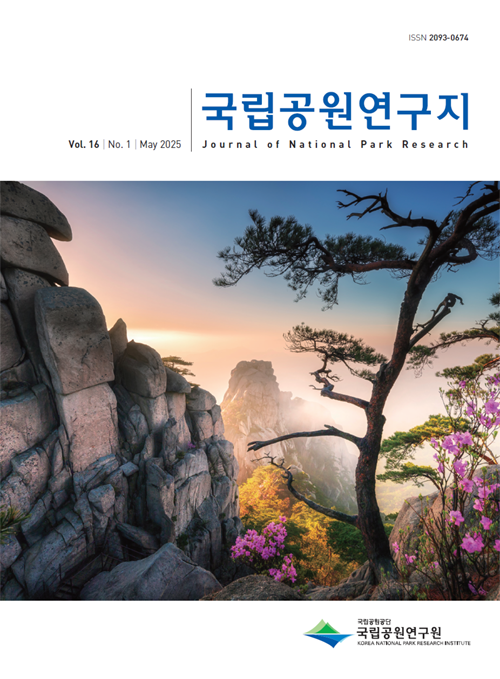- 영문명
- Fish Community Characteristics and River Health Assessment in Naejangsan National Park
- 발행기관
- 국립공원연구원
- 저자명
- 고명훈(Myeong-Hun Ko) 한미숙(Mee-Sook Han) 박승철(Seung-Chul Park)
- 간행물 정보
- 『국립공원연구지』제16권 제1호, 23~35쪽, 전체 13쪽
- 주제분류
- 자연과학 > 생물학
- 파일형태
- 발행일자
- 2025.05.31
이용가능
이용불가
- sam무제한 이용권 으로 학술논문 이용이 가능합니다.
- 이 학술논문 정보는 (주)교보문고와 각 발행기관 사이에 저작물 이용 계약이 체결된 것으로, 교보문고를 통해 제공되고 있습니다. 1:1 문의

국문 초록
내장산국립공원의 어류군집 특성 및 하천건강성을 밝히기 위해 2021년 6월부터 9월까지 조사를 실시하였다. 조사기간 동안 5개 지구, 23개 지점을 조사한 결과, 9과 31종 4,636개체의 어류가 채집되었다. 출현종 중 우점종은 갈겨니(상대풍부도 26.8%), 아우점종은 피라미(18.3%)였으며, 그 다음으로 밀어(13.9%), 버들치(10.2%), 긴몰개(6.2%), 돌고기(4.3%), 참갈겨니(4.2%), 칼납자루(4.1%), 참몰개(2.1%), 블루길(2.1%), 배스(1.5%) 등의 순으로 우세하였다. 한국고유종은 각시붕어, 칼납자루, 긴몰개, 참몰개, 돌마자, 참갈겨니, 참종개, 왕종개, 남방종개, 점줄종개, 눈동자개, 미유기, 섬진자가사리, 꺽지, 동사리, 얼록동사리 16종(고유화율 51.6%)으로 높았고, 외래종은 생태계교란 생물로 지정된 배스와 블루길을 포함하여 떡붕어 3종이 채집되었으며, 그 밖에 육봉형 어류로 밀어 1종이 출현하였다. 군집분석 결과, 우점도(0.493~1.000)는 상류로 갈수록 높아지고, 다양도(0.169~1.889)와 풍부도(0.446~2.124)는 하류로 갈수록 높아지며, 균등도(0.154~0.952)는 경향성이 없었다. 군집구조는 최상류(St. 1, 2, 7, 8, 9,18, 22)와 상류(11, 14, 15, 16, 19, 20, 23), 호소인근+중류(St. 3, 4, 6, 10, 12, 13, 17, 21), 호소(St. 15)로 구분되었다. 하천건강성은 매우 좋음 14개, 좋음 6개, 보통 2개, 나쁨 1개 지점으로 평가되어비교적 양호하였다. 하지만 국립공원 내에 생태계교란 생물인 배스와 블루길이 서식하고 있고, 일부 지역에 하천공사가 진행되고 있었으며, 다수의 어도가 없는 보와 사방댐이 설치되어 있는 등 교란 요인이 확인되었다. 따라서 내장산국립공원에서 어류의 안정적인 서식을 위해서는생태계교란 생물인 배스와 블루길을 구제하고, 보와 사방댐에 어도를 설치하며, 무분별한 하천공사는 지양하는 등 보존대책이 요구되었다.
영문 초록
This study examined the characteristics of fish communities and river health in the Naejangsan National Park, Korea, from June to September 2021. The survey identified 31 species across nine families from 23 survey stations in five districts. The dominant and subdominant species were Zacco temminckii (26.8%) and Z. platypus (18.3%), respectively. The second most abundant species were Rhinogobius brunneus (13.9%), Rhynchocypris oxycephalus (10.2%), Squalidus gracilis majimae (6.2%), Pungtungia herzi (4.3%), Z. koreanus (4.2%), Acheilognathus koreensis (4.1%), S. chankaensis tsuchigae (2.1%), Lepomis macrochirus (2.1%), and Micropterus salmoides (1.5%). Among the collected fish species, 16 (51.6%) were endemic to Korea: Rhodeus uyekii, Acheilognathus koreensis, S. gracilis majimae, S. chankaensis tsuchigae, Microphysogobio yaluensis, Z. koreanus, Iksookimia koreensis, I. long- icorpa, I. hugowolfeldi, Cobitis nalbanti, Pseudobagrus koreanus, Silurus microdorsalis, Liobagrus somjinensis, Coreoperca herzi, Odontobutis platycephala and O interrupta. In addition, three exotic species were recorded: M. salmoides and L. macrochirus, both classified as ecologically disturbed species, as well as C. cuvieri. A landlocked species, R. brunneus, was also identified. Community analysis revealed that dominance (0.493-1.000) was higher in the upstream areas, whereas diversity (0.169-1.889) and richness (0.446-2.124) were greater in the downstream areas. Evenness (0.154-0.952) showed no clear trend. The community structure was divided into four categories: uppermost stream (stations 1, 2, 7, 8, 9, 18, and 22), upper stream (stations 11, 14, 15, 16, 19, 20, and 23), near-lake + middle stream (stations 3, 4, 6, 10, 12, 13, 17, and 21), and lake (station 15). River health, assessed using the fish assessment index, was categorized as very good (14 stations), good (six stations), normal (two stations), or bad (one station). Although Naejang National Park is relatively well preserved, it faces ecological disturbances from species such as M. salmoides and L. macrochirus. Additionally, many weirs and debris barriers have been installed in streams, and river work has been observed in some areas. Therefore, conservation measures are needed to ensure stable fish habitats in the Naejangsan National Park. These measures include removing ecologically disturbed species (M. salmoides and L. macrochirus), installing fishways in weirs and debris barriers, and avoiding indiscriminate river work.
목차
서론
재료 및 방법
결과
고찰
사사
참고문헌
키워드
해당간행물 수록 논문
참고문헌
최근 이용한 논문
교보eBook 첫 방문을 환영 합니다!

신규가입 혜택 지급이 완료 되었습니다.
바로 사용 가능한 교보e캐시 1,000원 (유효기간 7일)
지금 바로 교보eBook의 다양한 콘텐츠를 이용해 보세요!




